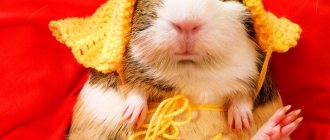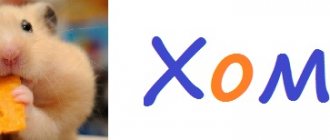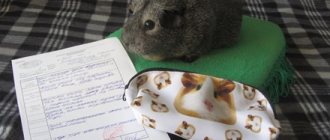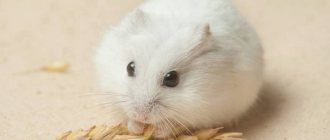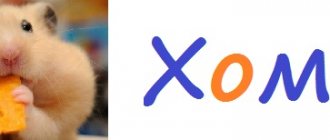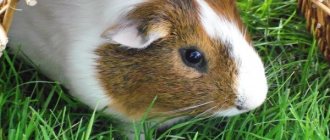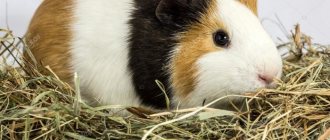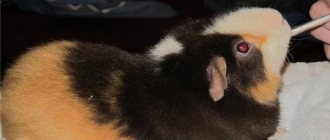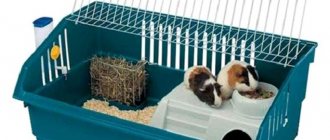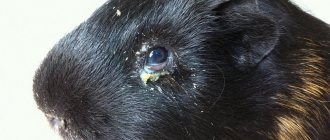/ Guinea pigs / California vaquita porpoise
0
2038
Article rating
The Californian porpoise is not the same as a certain breed of ornamental rodent that we are used to seeing in some homes as a pet. This is a rare species from a family of aquatic mammals, of which scientists estimate there are only about a hundred individuals left.
California vaquita porpoise
Description of the porpoise
The first mention of the mammal came in 1958, when 2 animal skulls were found. Only after 30 years were scientists able to describe the appearance, geography of distribution and habits of this creature, part of the order of cetaceans. The Californian guinea pig also has another name – vaquita, which means “little cow” in Spanish. This species of mammal may also be called "cove" and "Hafenschweinswal".
External signs
According to its description, the Californian porpoise is an animal with a similar body structure to that of other similar representatives. Stocky with a body structure formed by star-shaped fins on its sides, the Californian is the smallest species of all. Its length in most cases barely reaches 1.5 meters. In most cases, the animal weighs no more than 50-52 kg; in rare exceptions, the weight of a vaquita can reach 60 kg.
Among the distinguishing characteristics of the Californian guinea pig:
- large spectacle-shaped stripes around the eyes,
- black coloring of the lips and skin around the mouth, creating the image of a permanent smile,
- the color is dull with a lead-gray tint, while the color of the upper part of the body is gray or dark gray, and the color of the lower side of the body is white or light gray; between the two halves of the body, the lower (abdomen) and the upper (dorsal region), there is a fuzzy, blurred border ,
- rather large flippers, larger in size than those characteristic of other representatives of this species and at the same time thinner than those of other relatives, a shark-shaped fin on the back, distinguished by its sickle shape; some animals may not have a dorsal fin,
- The skull of the mammal is round in shape, much smaller compared to other representatives of its related species, and the rostrum (beak) is rather shortened and wide.
Among the representatives of this family of mammals, albinos are sometimes found in nature; their color is completely or partially white.
Lifespan
The maximum possible lifespan of the Californian porpoise species has been recorded as 21 years. Typically, in their natural environment, these animals live much shorter lives.
Interesting facts about the rodent:
- Guinea pigs were domesticated in the 5th millennium BC. e. Andean tribes of South America (today Colombia, Ecuador, Peru and Bolivia) in order to eat rodent meat. During archaeological excavations in Peru and Ecuador, statues of guinea pigs were found dating back to 500 BC. e. before 500 AD e. They were worshiped by the Mochica people. Nowadays, in South America, guinea pigs continue to be eaten (in Peru, up to 65 million animals are used for this purpose per year). Guinea pig meat is similar in taste and nutritional value to rabbit and chicken meat, and is considered dietary.
- Selection work to develop guinea pig breeds lasted from 1200 to 1532. And during the period of the Great Geographical Discoveries, traders from Spain, Holland and England brought pigs to Europe, where they gained popularity as pets at royal courts (for example, Queen Elizabeth I of England).
Article rating:
California breed of guinea pig Link to main publication
Related publications
- Name options for guinea pigs
External differences from dolphins
Some people confuse the species of these mammals with small dolphins, because these animals are similar in appearance and skeletal structure. Although vaquitas have a fish-like body with horizontal tail fins, their chest fins are shorter, located closer to the head and similar to modified forelimbs.
Some zoologists even attribute them to the dolphin family, but in fact there are no family ties between the vaquita and dolphins.
Also, unlike the dolphin community, all known varieties of vaquitas are much smaller in size, their skulls are more blunt in shape, their beaks lack the characteristic elongation of a dolphin, and some species may even lack a dorsal fin. Also, their teeth are not conical, but flattened.
Geography of distribution
Representatives of the Californian porpoise breed can be found in the northern region of the Sea of Cortez. They live in the waters of this bay of the same name, which separates the California peninsula from the Pacific coast of Mexico. The habitat of the Californian guinea pig includes a small area in the Colorado River delta with an area of about 40 sq.m. It is impossible to observe these rare mammals anywhere else.
Pacific Ocean Animal
Habitats
The vaquita's preferred habitat is shallow water. It settles in small bodies of water (lagoons), separated from the main column of ocean water by barrier sand islands and reefs formed by corals and algae. The water in such secluded places is warm and opaque.
At a depth of more than 30 meters, the Californian porpoise is found quite rarely.
In some cases, its habitats are in such shallow water that the mammal's back is visible on the surface of the ocean. Thanks to the constant ebb and flow of tides, in places where mammals like to spend time, metabolic convection processes constantly occur, saturating the water with oxygen and increasing its biological activity.
California breed standard
California Breed Standard¶
From: Peaks - February 19, 2015 1:50 pm
CALIFORNIA Head, Eyes, Ears 10
The head should be short and wide, the profile should be formed by smooth curves.
Muzzle: Broad and smoothly rounded near the nostrils. Eyes: Large, bright and protruding, set far apart. Ears: Large and drooping, set well spaced apart. Body, Shape 10
Should be short, broad, well built, with very high, broad shoulders.
Must be healthy, in good physical shape, with large muscle mass. Size should be appropriate for age Figure 50
Consist of even, clearly defined dark spots on the face, ears and paws, with a clear border separating them from the main color of the body. (in which) Spot (25) Should be visible, wide end at the nostrils, ideally pear-shaped, rising smoothly between the eyes; clearly defined, strongly colored black or rich milk chocolate. Ears (5) Should be intensely colored black or rich milk chocolate, down to the base. Feet (20) Should be a uniform, intense color of black or rich milk chocolate, clearly demarcated, with the color distributed well over the legs, including the claws and paw pads.
Color 25 The main color must comply with the requirements of the English Selfie standard, be uniform, pure and evenly distributed from the ends of the hair to the skin. Wool 5
Should be soft, silky, guard hairs should be removed.
COLOR DESCRIPTIONS California Guinea Pigs are recognized in the following primary colors: White Cream Saffron Buffalo Gold Red
Eye color must correspond as closely as possible to the eye color requirements for the primary color of the English Selfie standard.
EXPLANATIONS Juniors under 5 months of age shall not be excessively penalized for hair of a primary color on the paws and on the mask. At 5-8 months there may still be white hair on the inside of the ear, this should not be penalized.
NB There is a tendency for skin pigment to form in cold weather. The trend is opposite in hot weather, when the Spots, especially the nose and paw spots, may lose intensity. In poorly colored Blacks, the spot and feet may appear brown, but the black ears should dispel any doubt about the Chocolate.
BREED DISQUALIFYING FEATURES White areas in markings. Unpigmented areas on the paw pads. Unpigmented claws.
BREED FAULTS Heterogeneous markings interspersed with white hairs creating a “pepper” effect. Poor separation between Spots and body color. Excessive pigment on the body, creating a “dirty” effect.
Source
Security status
Despite the fact that people have never hunted the Californian porpoise, representatives of the genus are protected by the International Book with the status assigned to them “critically endangered”:
- in 1997 there were 567 individuals,
- by 2015 there were no more than 60 vaquitas left,
- in 2016, scientists stated that the mammal population consists of only 30 representatives.
This is one of the unique animals that has no relatives. The closest related subspecies is Burmeister's animal, whose geographical habitat is located near the coast of Peru.
The Mexican government has created a reserve for the vaquita at the mouth of the Colorado River and the Gulf to preserve and replenish the population of the mammal.
Discovered and recognized by scientists in 1985, the vaquita population has been significantly declining due to bycatch in fine nets set by local fishermen to catch small shrimp and the small totoaba fish, valued for its medicinal value. Along with this prey, an endangered species of mammal gets caught in the net, therefore, in the absence of a legal ban on the use of fishing nets, this species of porpoise can be completely exterminated. Damage to the California porpoise population is also caused by the use of chlorine-containing pesticides, the residues of which end up in runoff; inbreeding and depletion of Colorado River runoff may be aggravating factors.
Habits
The Californian porpoise is quite cautious and avoids meeting people, avoids boats and other floating technical equipment. Being unpretentious mammals leading a secretive lifestyle, vaquitas prefer to hide in dirty water. They emerge into the air from the water column only for a portion of fresh air, making a slow movement in the forward direction, making several horizontal circles around themselves, practically without disturbing the smooth surface of the water, and disappear, for quite a long time.
When exhaling, the vaquita does not emit a characteristic clear water fountain, but produces a puffing sound characteristic of any representative of this species, sharp and quite loud.
The behavior of the vaquita, which is rarely found in nature, has been little studied. Many scientists are inclined to believe that the animal swims at low speed during its life, is slow, and feeds while moving in the water. The Californian representative of porpoises, as befits its related species, lives in small groups of 1-3 mammals, but is often found alone. The size of one herd can in some cases number about 8-10 representatives.
Communication
Representatives of the vaquita family communicate with each other by transmitting information through a variety of whistles and clicks. The signals they use, unlike those emitted by dolphins with their inherent monotony, are impulsive in nature. Scientists distinguish between the signals of these animals: some serve for echolocation, others are intended to demonstrate the emotional state of the mammal.
Nutrition
The diet of the California variety of porpoises consists mainly of fish. In the process of studying these mammals, scientists recorded 17 species of fish that the mammal feeds on, and all of them belong to the bottom ones - those that live on the bottom of the sea in the areas of the animal’s geographical distribution. In addition to fish, the vaquita's daily menu may include shellfish, squid and shrimp. It is helped to obtain food in the water column by its teeth, which in their appearance resemble small spatulas, of which there can be from 34 to 42 pairs. While diving for prey, animals are able to linger under the water for up to 5 minutes.
Pigs native to California
The California Shorthair breed appeared recently - about twenty years ago, and is one of the youngest breeds today.
The animals were bred in Peru, from where they came to the USA and there they received a second birth and a large number of colors. California-colored animals arrived in Europe in 2012. The first male introduced to the continent was Macho Picchu. It is his descendants that are still used in many European nurseries. The Californians arrived in Russia in November 2013.
Reproduction
The offspring of the Californian porpoise appears when the weather warms up with the arrival of the spring period or at the beginning of the summer season. As scientists suggest (due to the lack of knowledge about these mammals, there is no exact information about this), pregnancy of a mammal lasts on average 10-11 months. For one litter, the Californian porpoise usually brings 1 cub, in rare cases - 2. The initial length of the baby is about 0.6-0.7 m, but scientists have not determined the exact weight with which the baby is born. For four to six months, the female vaquita feeds her baby with milk.
Fur color
Coloring in guinea pigs lasts 8–12 weeks from birth and depends on the ambient temperature: in the cold the color of the fur appears bright, and in the warm it becomes pale. Due to the fact that the color gene is dominant, there are no carriers of the Californian gene. Either the Californian breed is born or they are carriers of an unwanted color.
Among the variety of fur colors, this breed has several main ones:
- blue;
- cream and shade (black-cream);
- red-black;
- chocolate and shades (light and dark);
- lilac;
- buffalo.
